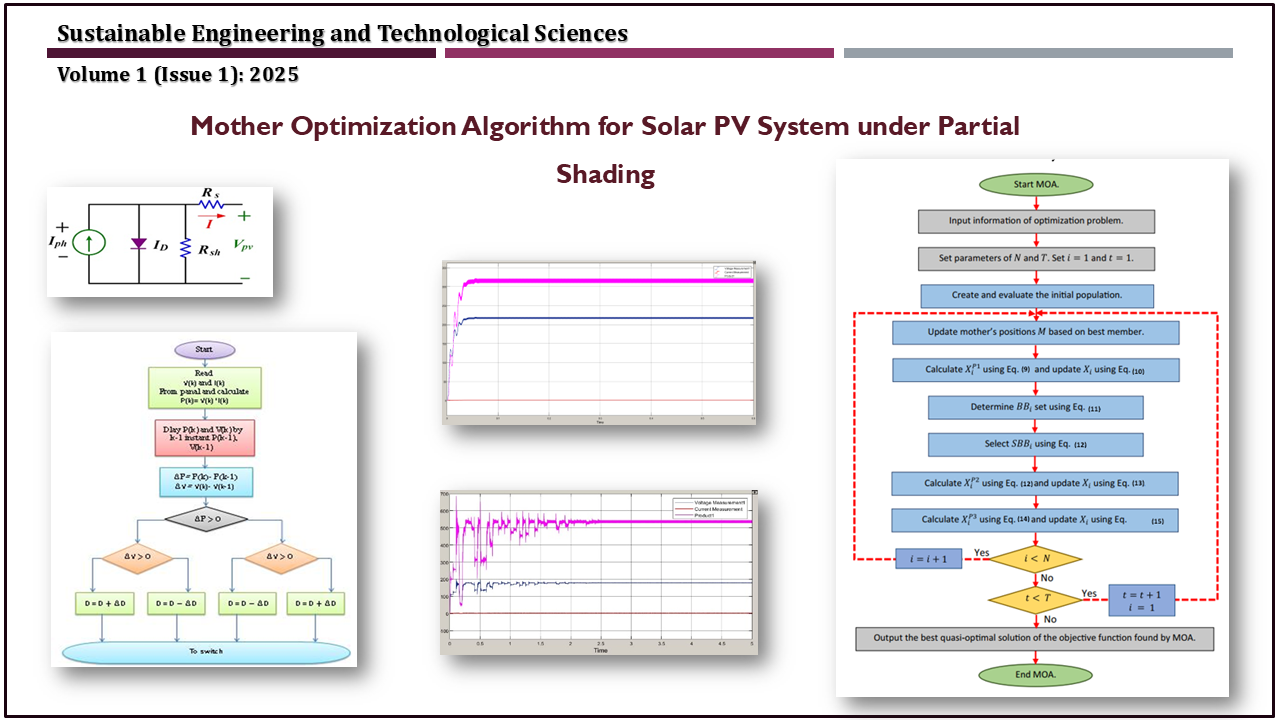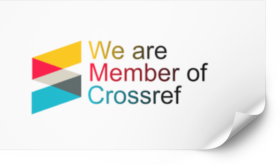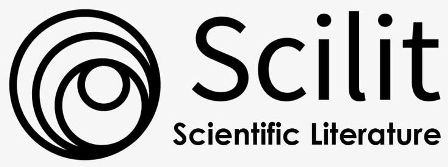Mother Optimization Algorithm for Solar PV System Under Partial Shading
DOI:
https://doi.org/10.70516/4rdfh404Keywords:
Mother Optimization Algorithm (MOA), Partial Shading Condition (PSC), Maximum Power Point (MPPT), Photovoltaic (PV).Abstract
This work investigates the combined use of the traditional Perturb and Observe (P&O) algorithm with the Mother Optimization Algorithm (MOA) for tracking the Global Maximum Power Point (GMPP) and a DC-DC boost converter. The results indicate that the MOA algorithm captures GMPP with 98% efficiency in MATLAB Simulink running under PSC, while the P&O approach fails to capture GMPP.
Downloads
References
R. El Idrissi1, A. Abbou, M. Mokhlis and M. Salimi, “Adaptive backstepping controller design based MPPT of the single-phase grid connected PV system”, Int. J. Intell. Eng. Sys. Vol. 14(3), PP. 282–293, 2021. DOI: https://doi.org/10.22266/ijies2021.0630.24
M. Abdel-Salam, M.T. El-Mohandes and M. El-Ghazaly, ”An efficient tracking of MPP in PV systems using a newly-formulated P & O MPPT method under varying irradiation levels”, J. Electr. Eng. Technol. Vol. 15(1), pp. 501–513, 2020. DOI: https://doi.org/10.1007/s42835-019-00283-x
A. Harrag and S. Messalti, “PSO-based SMC variable step size P & O MPPT controller for PV systems under fast changing atmospheric conditions”, Int. J. Number. Model. Electron. Networks, Devices Fields vol. 32(5), 2019. DOI: https://doi.org/10.1002/jnm.2603
L. Shang, H. Guo and W. Zhu,” An improved MPPT control strategy based on incremental conductance algorithm”,Prot. Control Mod. Power Syst. Vol. 5(1), 2020. DOI: https://doi.org/10.1186/s41601-020-00161-z
M. G. Yahya and M. G. Yahya, “Comparative study of two cases of single-phase HCMLI using IPDPWM technique for standalone PV system,” International Journal of Nonlinear Analysis and Applications, vol. 13, no. 1, pp. 2395-2409, doi:10.22075/IJNAA.2022.5940.
A. W. Ibrahim, et al., “PV maximum power-point tracking using modified particle swarm optimization under partial shading conditions”, Chinese Journal of Electrical Engineering, Vol. 6, No. 4, pp. 106-121, Dec. 2020 , doi: 10.23919/CJEE.2020.000035. DOI: https://doi.org/10.23919/CJEE.2020.000035
M. Oulcaid, H. E. Fadil, A. Yahya, et al., “ Maximum power point tracking algorithm for photovoltaic systems under partial shaded conditions”, IFAC-Papers OnLine, pp. 217-222, 2016 , doi: 10.1109/EPEPEMC.2014.6980572. DOI: https://doi.org/10.1016/j.ifacol.2016.07.954
E. Soliman, H. Abd El-Halim, A. Refky, " A proposed an interactive reliable aggregated photovoltaic cell for a longer time solar energy extraction ", International Journal of Power Electronics and Drive System, Vol 13, No 1: March 2022 4, doi: 10.11591/ijpeds. DOI: https://doi.org/10.11591/ijpeds.v13.i1.pp537-546
A. Siva, V. Rajendran, "A novel auxiliary unit based high gain DC-DC converter for solar PV system with MPPT control", International Journal of Power Electronics and Drive System, Vol 13, No 4: December 2022, pp. 2386-2395, doi: 10.11591/ijpeds.v13.i4.pp2386-239. DOI: https://doi.org/10.11591/ijpeds.v13.i4.pp2386-2395
K. Boudaraia, H. Mahmoudi and A. Abbou,” MPPT design using artificial neural network and backstepping sliding mode approach for photovoltaic system under various weather conditions”, Int. J. Intell. Eng. Syst. Vol. 12(6) pp. 177–186, 2019. DOI: https://doi.org/10.22266/ijies2019.1231.17
González-Longatt, Francisco M. ,”Model of Photovoltaic Module in Matlab”, i Cibelec 2005, pp. 1 5,2015.
J. Arati, A. Khan, and S. P. Afra., “ Comparison of Half Cut Solar Cells with Standard Solar Cells”, 2019 Advances in Science and Engineering Technology International Conferences (ASET). IEEE, 2019.
I. Matoušová, P. Trojovský, M. Dehghani, et al. “Mother optimization algorithm: a new human-based metaheuristic approach for solving engineering optimization”. Sci Rep 13, 10312 (2023). https://doi.org/10.1038/s41598-023-37537-8 DOI: https://doi.org/10.1038/s41598-023-37537-8
M. G. Yahyaa, M. G. Yahyab, “Comparative study of two cases of single-phase HCMLI using IPDPWM technique for standalone PV system”, Int. J. Nonlinear Anal. Appl. 13 (2022) No. 1, pp. 2395-2409.
C.C. Ahmed, M. Cherkaoui and M. Mokhlis,” PSO-SMC controller based GMPPT technique for photovoltaic panel under partial shading effect”, Int. J. Intell. Eng. Syst. Vol.13(2), pp. 307–316, 2020. DOI: https://doi.org/10.22266/ijies2020.0430.30
H. F. Hashim, M. M. Kareem, W. Kh. Al-Azzawi, A. H. Ali," Improving the performance of photovoltaic module during partial shading using ANN", International Journal of Power Electronics and Drive System, vol 12, no 4: December 2021, doi: 10.11591/ijpeds.v12.i4.pp2435-2442. DOI: https://doi.org/10.11591/ijpeds.v12.i4.pp2435-2442
F. Kadir, S.Z. Mohammad Noor, A.H. Faranadia, K.S. Muhammad, " Modeling and simulation of DC to DC boost converter using single phase matrix converter topology ", International Journal of Power Electronics and Drive System, vol 11, no 2: June 2020, doi: 10.11591/ijpeds.v11.i2.pp774-784. DOI: https://doi.org/10.11591/ijpeds.v11.i2.pp774-784
T.W. Hariyadi and A. Adriansyah, “Comparison of DC-DC converters boost type in optimizing the use of solar panels”, 2nd Int. Conf. Broadband Commun. Wireless Sensors and Powering (BCWSP), Yogyakarta, Indonesia, (2020) pp.189–194. DOI: https://doi.org/10.1109/BCWSP50066.2020.9249464

Downloads
Published
Issue
Section
Categories
License
Copyright (c) 2024 Massara Yahya (Author)

This work is licensed under a Creative Commons Attribution-NonCommercial-NoDerivatives 4.0 International License.
Open Access and Copyright: SETS operates as an open-access journal, making all its articles freely available to everyone. Published content is licensed under the Creative Commons Attribution International Public License (CC BY 4.0). This license allows individuals and organizations to:
- Download, share, distribute, and print full texts of articles
- Reproduce or link to articles in any medium,
While authors retain copyright for their published work on the SETS website, the journal actively promotes and tracks citations to increase recognition for their research.
In essence, CC-BY-4.0 encourages the widest possible dissemination and utilization of published articles as long as written permission and appropriate credit are given to the authors.







